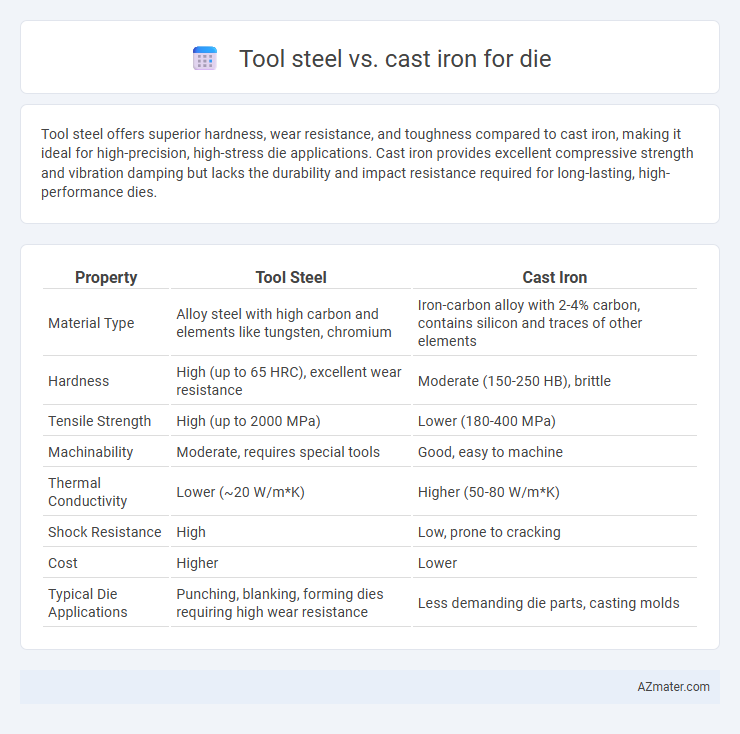Tool steel offers superior hardness, wear resistance, and toughness compared to cast iron, making it ideal for high-precision, high-stress die applications. Cast iron provides excellent compressive strength and vibration damping but lacks the durability and impact resistance required for long-lasting, high-performance dies.
Table of Comparison
| Property | Tool Steel | Cast Iron |
|---|---|---|
| Material Type | Alloy steel with high carbon and elements like tungsten, chromium | Iron-carbon alloy with 2-4% carbon, contains silicon and traces of other elements |
| Hardness | High (up to 65 HRC), excellent wear resistance | Moderate (150-250 HB), brittle |
| Tensile Strength | High (up to 2000 MPa) | Lower (180-400 MPa) |
| Machinability | Moderate, requires special tools | Good, easy to machine |
| Thermal Conductivity | Lower (~20 W/m*K) | Higher (50-80 W/m*K) |
| Shock Resistance | High | Low, prone to cracking |
| Cost | Higher | Lower |
| Typical Die Applications | Punching, blanking, forming dies requiring high wear resistance | Less demanding die parts, casting molds |
Introduction to Die Materials: Tool Steel vs Cast Iron
Tool steel offers superior hardness, wear resistance, and toughness compared to cast iron, making it ideal for high-precision die applications. Cast iron is valued for its excellent vibration damping and cost-effectiveness but lacks the durability needed for intensive die usage. Selecting the right die material depends on factors such as production volume, required dimensional accuracy, and thermal conductivity.
Chemical Composition Differences
Tool steel contains higher carbon content (0.5-1.5%) and alloying elements like chromium, vanadium, and molybdenum, enhancing hardness, wear resistance, and toughness for die applications. Cast iron typically has 2-4% carbon and significant silicon content (1-3%), which increases brittleness but improves castability and compressive strength. These compositional differences result in tool steel being preferred for precision die work requiring durability, while cast iron suits less demanding mold structures.
Mechanical Properties Comparison
Tool steel exhibits superior mechanical properties for die applications, including higher hardness, tensile strength, and wear resistance compared to cast iron. Cast iron offers good compressive strength and excellent damping capacity but lacks the toughness and impact resistance of tool steel. The enhanced toughness and fatigue resistance of tool steel make it more suitable for dies subject to high stress and repetitive loading.
Wear Resistance: Tool Steel vs Cast Iron
Tool steel exhibits significantly higher wear resistance compared to cast iron, making it ideal for die applications requiring durability under repeated stress and abrasion. Its alloy composition, including elements like chromium, vanadium, and molybdenum, enhances hardness and toughness, reducing wear rates during high-impact operations. Cast iron, while cost-effective and good for compressive strength, tends to wear faster in die usage due to its brittle microstructure and lower hardness.
Machinability and Workability
Tool steel exhibits superior machinability compared to cast iron due to its uniform composition and ability to maintain sharp cutting edges, making it ideal for precise die manufacturing. Cast iron has lower workability because of its brittleness and higher carbon content, which can lead to cracks or fractures during machining processes. The enhanced toughness and wear resistance of tool steel provide longer die life and smoother finishing in industrial applications.
Cost Implications for Die Production
Tool steel offers higher durability and wear resistance in die production but comes at a significantly higher cost compared to cast iron. Cast iron provides a more affordable option with easier machinability, yet it may require more frequent maintenance and replacement due to lower toughness. Choosing between tool steel and cast iron impacts overall production expenses, balancing initial material investment against long-term operational costs.
Heat Treatment and Hardness
Tool steel, renowned for its superior heat treatment capabilities, achieves higher hardness levels through processes like quenching and tempering, resulting in excellent wear resistance and toughness essential for die applications. Cast iron, while offering good compressive strength and castability, generally exhibits lower hardness and limited heat treatment options, making it less suitable for high-stress die environments. Heat-treated tool steel dies maintain dimensional stability and hardness up to 60 HRC, outperforming cast iron which typically ranges below 30 HRC after heat treatment.
Applications in Die Making
Tool steel exhibits superior hardness, wear resistance, and toughness, making it ideal for high-precision dies used in metal stamping, forging, and extrusion processes. Cast iron, while offering excellent compressive strength and damping capacity, is typically chosen for low-stress dies or mold bases where dimensional stability is less critical. The selection between tool steel and cast iron in die making hinges on application demands, with tool steel preferred for intricate, high-wear dies and cast iron suited for cost-effective, low-load applications.
Longevity and Maintenance Requirements
Tool steel exhibits superior longevity compared to cast iron for die applications due to its enhanced hardness, wear resistance, and ability to maintain a sharp edge under high stress conditions. Maintenance requirements for tool steel dies are generally lower, as their resistance to chipping and deformation reduces the frequency of repairs and resharpening. Cast iron, while cost-effective, tends to suffer from brittleness and faster wear, leading to more frequent maintenance cycles and potential downtime.
Choosing the Right Material for Specific Die Uses
Tool steel offers superior hardness, wear resistance, and toughness, making it ideal for high-precision dies requiring repeated impacts and fine detail. Cast iron provides excellent compressive strength and vibration damping, suitable for large, less intricate dies where cost efficiency and stability are priorities. Selecting the right material depends on die complexity, production volume, and performance demands, with tool steel favored for durability and cast iron for cost-effective, heavy-duty applications.

Infographic: Tool steel vs Cast iron for Die
 azmater.com
azmater.com